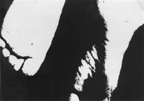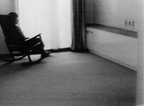Filmmakers Information Center—Searching for New Contexts
PART II Screenings: Two approaches to Japanese experimental film history
| Program B: Defamiliarization and Image |
Ai (LOVE)
 JAPAN / 1963 / B&W / 16mm / 10 min
JAPAN / 1963 / B&W / 16mm / 10 min
Director: Iimura Takahiko
A visual artist who started making experimental movies in the early 1960s, Iimura continues his activities on an international scale to this day. Ai (LOVE), an early work known as a conceptual piece, is composed of close-up shots of the body, and has a sensual feel. The piece features improvisational music by Yoko Ono.
Tokyo Honeymoon
 JAPAN / 1985 / Color / 8mm / 13 min
JAPAN / 1985 / Color / 8mm / 13 min
Director: Aoi Katsumi
A member of the former Voyant Cinematheque, a group which promoted personal filmmaking mainly in the Kansai region, Aoi creates tough images while maintaining a private point of view. This work focuses on the theme of Tokyo, an alien place for the artist, and shows a series of images which maintain tension through encounters with various landscapes.
The Mercury
 JAPAN / 1995 / Color / 8mm / 20 min
JAPAN / 1995 / Color / 8mm / 20 min
Director: Nagaya Miho
Nagaya Miho started out making private documentaries, but has since shifted to creating even more personally developed works. By layering different aspects of light, for example lightning and blinking fluorescent lights, The Mercury leads introspective images to a release.
Rocking Chair
 JAPAN / 2000 / Color / 16mm / 13 min
JAPAN / 2000 / Color / 16mm / 13 min
Director: Kano Shiho
While continuing to stoically shoot casual, everyday scenery, the artist succeeds in creating images with the peculiar space and time that exist only in film. Rocking Chair shoots an interior through gently alternation between light and shadow, and won the Best International Film Award at this year’s Images Festival in Toronto.
 A Cross Section of Japanese Experimental Film
A Cross Section of Japanese Experimental Film
The quest for avant-garde expression in film began in Europe in the 1920s. The Dadaists and Surrealists in particular set about explorating of free expressions entirely different from film hitherto, and were the predecessors of experimental films to come.
What those early works had in common was that they emphasized the essential originality of film. In this case, we can observe it from two different dimensions. One is the purity of the image which film can offer. The other is the structural frame that materializes the image. For example, the former dimension can be seen in surrealist film, and the latter in abstract and structuralist film. Those two cannot be strictly differentiated, but can still be pointed at as the main essential characteristics possessed by experimental film.
Works influenced by European experimental film first appeared in Japan in the 1930s. Thus avant-garde cinematic expression has been present in Japan since a quite early period. However, the production of this sort of films did not become a movement until the post-war era. Especially after the 1960s, Japan saw an upsurge in filmmakers inspired by American underground films. More work has been produced since then and thus we have come to this day. Even from a global perspective, Japan can be counted among those countries that are enthusiastic about experimental filmmaking.
This program aims to introduce such Japanese experimental film methodically. For this purpose, we have selected works from the 1960s, a period during which experimental film blossomed for the first time, to works of the present day. The two categories of “Repetition and Structure” and “Defamiliarization and Image” correspond with the two dimensions which experimental film essentially possesses. This program should illuminate the fact that Japanese experimental film stands within a historical context, while at the same time has experienced its own particular evolution in Japan.
|
Nishimura Tomohiro
Born in 1963. Graduated from the Image Forum Institute of the Moving Image in 1990. Began making films while a student at Image Forum. In 1993, “Warhol / Cinematic Minimalism” placed in the 11th Arts Critique awards organized by publisher Bijutsu Shuppan. Active since then in art and film criticism, not only as an author but also as a curator and as a judge for open art competitions. Published works include the co-authored The Creative Specificities and Possibilities Cinematic Expression (Kadokawa Shoten). |
